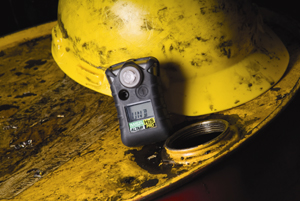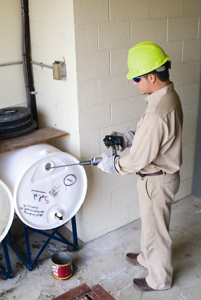5 Things to Know About Confined Space Safety
May 1, 2008
 Confined spaces represent major health and safety risks for construction workers. Recognition and planning for confined space work can mean the difference between a job well done and disaster.
Confined spaces represent major health and safety risks for construction workers. Recognition and planning for confined space work can mean the difference between a job well done and disaster. Here we will discuss some basics, such as how to define a confined space and necessary measures to protect workers functioning within them. Mentioned briefly are five issues pertaining to construction worker awareness when dealing with hazardous gases within confined spaces.
1. Defining Confined Spaces
A confined space is an area large enough for an employee to bodily enter and perform work, has limited or restricted means of entry or exit and is not designed for continuous human occupancy. Typical examples where hazardous gases are found include sewers, tanks, pipelines, pits, manholes, tunnels and underground vaults. It’s best to treat unknown areas as if they are confined spaces and to take all necessary safety precautions.
2. Causes of Atmospheric Confined Space Hazards
Atmospheric hazards expose workers to a risk of death, incapacitation, injury or acute illness from oxygen deficiency or enrichment, combustible gases and toxic contaminants. Methane releases, oxidation, battery recharging and inerting operations can create unstable environments leading to combustibility, chemical reactions and oxygen displacement within confined spaces. Chemicals can absorb materials, which may leach back out of walls. Accidental leaks or spills can create hazards by emission of fumes and vapors.
Natural gas (methane) is often found in sewers, manholes and pipelines and can combine with air and an ignition source to reach potentially combustible levels. Hydrogen sulfide (H2S), a colorless gas with a rotten egg smell, is often found in sewers and petrochemical operations. H2S can be combustible and toxic; H2S poisoning can cause unconsciousness and respiratory arrest.
3. Procedures for Confined Space Worker Entry
On Feb. 1, 1999, OSHA Standard on Permit-Required Confined Spaces, 29 CFR Part 1910.146, went into effect. In short, before anyone enters a confined space, an entry permit must be completed by supervisory personnel. Among other specifics, permits must clearly identify the confined space’s location, entry date, purpose, duration of occupancy, hazards and acceptable entry conditions, test results and rescue/emergency services. This regulation clearly defines workers’ rights when entering potentially life-threatening confined spaces. Among other requirements, employers must use a calibrated, direct-reading instrument to ensure safe confined space entry.
4. Personal Gas Detection for Confined Space Entry
 Battery-powered, direct-reading portable gas detection instruments are practical devices for monitoring confined space atmospheres and are classified into two groups — single-gas and multi-gas instruments. Typically, multi-gas instruments monitor a combination of oxygen deficiency or enrichment, combustible gases and certain toxic gases. Regardless of which instrument type is used to check environmental gas concentrations, regular monitoring should be performed during all confined space operations to account for possible changes in contaminant levels.
Battery-powered, direct-reading portable gas detection instruments are practical devices for monitoring confined space atmospheres and are classified into two groups — single-gas and multi-gas instruments. Typically, multi-gas instruments monitor a combination of oxygen deficiency or enrichment, combustible gases and certain toxic gases. Regardless of which instrument type is used to check environmental gas concentrations, regular monitoring should be performed during all confined space operations to account for possible changes in contaminant levels. 5. Importance of Worker Training
It’s essential that among other considerations, confined space entrants have and are trained to use appropriate gas detection equipment for a given environment and must adhere to the entry permit’s requirements. Training for confined space entry must be certified. Employers should ensure that confined space entrants are familiar with hazard recognition, communication, warnings, protective equipment and self-rescue procedures.
Upon completion of a confined space entry, all personnel should have left the work area, the confined space should be secured and the entry permit cancelled.
Keshwar Anroedh is a MSA product line manager-portable gas detection, which is based in Pittsburgh, Pa.
